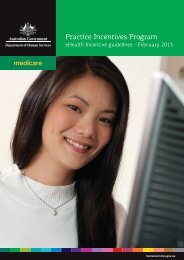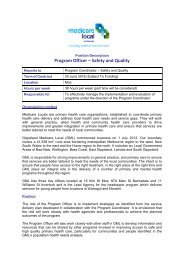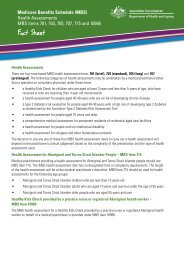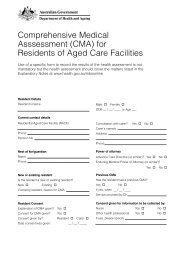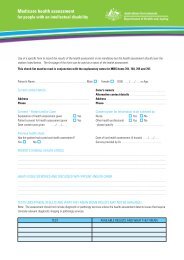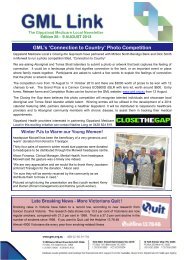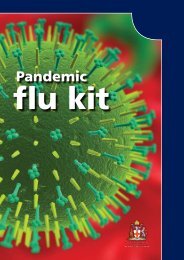Australian Immunisation Handbook 9th Edition - Goodstart Training ...
Australian Immunisation Handbook 9th Edition - Goodstart Training ...
Australian Immunisation Handbook 9th Edition - Goodstart Training ...
You also want an ePaper? Increase the reach of your titles
YUMPU automatically turns print PDFs into web optimized ePapers that Google loves.
to non-Indigenous adults. 3 Younger Indigenous adults suffer an even greater<br />
relative burden than non-Indigenous younger adults, at least 7 times higher<br />
for hospitalisations, and 28 times higher for death, 3 probably related to a high<br />
prevalence of risk factors such as diabetes, renal disease and excessive alcohol use. 2<br />
The most common complication of influenza is secondary bacterial pneumonia,<br />
and influenza vaccine has been shown to be effective in preventing pneumonia<br />
and death in the elderly. 23 Therefore, yearly influenza vaccination is<br />
recommended for all Aboriginal and Torres Strait Islander adults aged ≥15 years.<br />
Pneumococcal polysaccharide vaccine<br />
Studies in far north Queensland and the Kimberley have demonstrated a<br />
favourable impact of the 23-valent pneumococcal polysaccharide vaccine<br />
(23vPPV) on rates of invasive pneumococcal disease in Indigenous adults, 18,24,25<br />
but, at a national level, disparities in disease rates between Indigenous and non-<br />
Indigenous adults remain. As is the case for influenza and pneumonia, rates of<br />
invasive pneumococcal disease are highest in older Indigenous adults, with rates<br />
around 4 times higher in Indigenous compared to non-Indigenous adults aged<br />
≥50 years. 3 Rates in younger adults are slightly lower, but the relative difference<br />
between Indigenous and non-Indigenous is much greater, around 12 times higher<br />
in Indigenous compared to non-Indigenous adults aged 25–49 years. 3 This has<br />
been attributed to a high prevalence of at-risk conditions such as diabetes, renal<br />
disease and excessive alcohol use. 26<br />
23vPPV is recommended for all Aboriginal and Torres Strait Islander people<br />
aged ≥50 years, and for those aged 15–49 years who have high-risk underlying<br />
conditions, and has been funded nationally for people in these categories since<br />
1999. Eligibility for Indigenous adults may be broader than this in some regions;<br />
jurisdictional health authorities should be contacted for further information. A<br />
single revaccination is recommended after 5 years, and a second revaccination is<br />
recommended in some circumstances. See Chapter 3.15, Pneumococcal disease for<br />
more details.<br />
Other vaccines<br />
The first ever outbreak of Japanese encephalitis (JE) in Australia occurred in the<br />
remote outer islands of the Torres Strait in 1995. JE vaccine was first offered to<br />
the residents of these islands in late 1995 and, since then, the vaccine has been<br />
integrated into the childhood vaccination schedule commencing at 12 months of<br />
age (see Chapter 3.10, Japanese encephalitis). 27<br />
Service delivery<br />
General Practitioners, Aboriginal Community Controlled Health Services,<br />
Community Health Services, the Royal Flying Doctor Service and State/Territory<br />
Corrective Services all provide substantial levels of vaccination services to<br />
Aboriginal and Torres Strait Islander people, and are important to the success of<br />
programs to vaccinate Indigenous people. While vaccination coverage estimates<br />
2.1 Vaccination for<br />
Aboriginal and Torres<br />
Strait Islander people<br />
Vaccination for Aboriginal and Torres Strait Islander people 73



